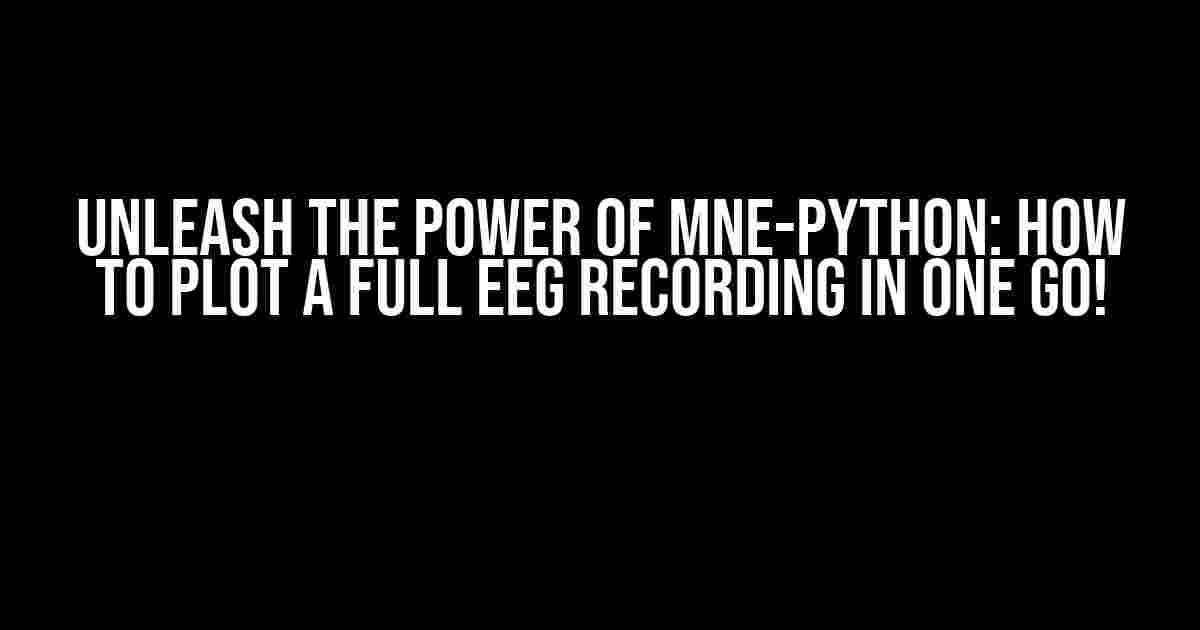Are you tired of scrolling through epochs in MNE-Python, trying to make sense of your EEG data? Do you want to visualize your entire recording in one go, without the hassle of chopping it up into smaller pieces? Look no further! In this article, we’ll take you on a journey to master the art of plotting a full EEG recording in MNE-Python.
Why Plot a Full EEG Recording?
Plotting a full EEG recording can be incredibly insightful, especially when working with large datasets. By visualizing the entire recording, you can:
- Identify patterns and trends that might be missed when looking at individual epochs
- Get a better understanding of the overall signal quality and noise levels
- Quickly spot artifacts and anomalous activity
- Enhance your research and analysis by visualizing the entire recording in context
Preparation is Key
Before we dive into the plotting magic, let’s make sure you have the necessary ingredients:
- MNE-Python installed: If you haven’t already, install MNE-Python using pip:
pip install mne - EEG data loaded: Load your EEG data into MNE-Python using the
mne.io.read_raw_*functions (e.g.,mne.io.read_raw_edf()) - Data preprocessed: Apply any necessary preprocessing steps to your data, such as filtering, resampling, or epoching
Plotting the Full EEG Recording
Now that we’re ready, let’s create a figure that showcases the entire EEG recording. We’ll use the mne.viz.plot_raw function, which provides a range of customization options.
import mne
# Load your EEG data
raw = mne.io.read_raw_edf('your_file.edf')
# Plot the full EEG recording
mne.viz.plot_raw(raw, duration=10, scalings=dict(eeg=50e-6),
title='Full EEG Recording',
show=True)This code snippet will generate a figure with the entire EEG recording, with each channel displayed separately. The duration parameter controls the length of the plot, while the scalings dictionary allows you to adjust the y-axis scale for each channel type.
Tweaking the Plot
To further customize your plot, you can use the following options:
| Parameter | Description |
|---|---|
duration |
Specifies the length of the plot in seconds |
scalings |
A dictionary with channel types as keys and y-axis scaling factors as values |
start |
Specifies the starting point of the plot in seconds |
proj |
A boolean indicating whether to apply SSP projections to the data |
mne.viz.plot_raw(raw, duration=10, scalings=dict(eeg=50e-6),
start=100, proj=True, title='Customized Full EEG Recording',
show=True)This updated code snippet applies SSP projections to the data and starts the plot 100 seconds into the recording.
Additional Tips and Tricks
To get the most out of your full EEG recording plot, keep the following tips in mind:
- Use a reasonable duration: Choose a duration that balances data visualization with performance. Longer durations can lead to slower plotting times.
- Customize channel orders: Use the
orderparameter to reorder channels and highlight specific features or patterns - Experiment with different scaling factors: Adjust the y-axis scaling for each channel type to better visualize specific frequency bands or features
Conclusion
With these simple yet powerful techniques, you can now unleash the full potential of MNE-Python and plot your entire EEG recording in one go! By visualizing your data in context, you’ll gain a deeper understanding of the underlying signals and patterns, ultimately enhancing your research and analysis.
Remember, practice makes perfect. Experiment with different customization options, tweak the plot to your heart’s content, and don’t be afraid to try new things. Happy plotting!
Bonus Tip: Want to save your plot for later use or sharing? Simply add the save parameter to your mne.viz.plot_raw function call, specifying the desired file format and path. For example: mne.viz.plot_raw(raw, ..., save='full_eeg_recording.png')
Frequently Asked Question
Get ready to dive into the world of EEG signal processing with MNE-Python! If you’re tired of scrolling through epochs and want to plot a full EEG recording, we’ve got you covered. Here are some frequently asked questions to help you achieve your goal:
What’s the simplest way to plot a full EEG recording in MNE-Python?
You can use the `plot` function from MNE-Python’s `raw` module. Simply call `raw.plot()` and voilà! You’ll get a beautiful plot of your entire EEG recording.
Can I customize the plot to show specific channels or time ranges?
Absolutely! You can pass various arguments to the `plot` function to customize the output. For example, use `raw.plot(picks=[‘chan1’, ‘chan2’])` to show only specific channels, or `raw.plot(start=10, duration=30)` to display a 30-second time range starting from 10 seconds.
How can I highlight specific events or artifacts in the plot?
You can use the `events` argument to highlight specific events or artifacts in the plot. For example, `raw.plot(events=events, event_colors=[‘red’, ‘blue’])` will color-code the events according to their type. You can also use `raw.plot(vlines=[‘start’, ‘stop’])` to add vertical lines at specific time points.
Can I save the plot as an image file or integrate it into a report?
Yes! You can use the `savefig` method to save the plot as an image file (e.g., PNG, PDF, or EPS). Alternatively, you can use Matplotlib’s `tight_layout` and `figure` objects to customize the plot and integrate it into a report.
Are there any advanced visualization options available in MNE-Python?
MNE-Python offers a range of advanced visualization options, including 3D plotting, topographic maps, and time-frequency representations. Check out the MNE-Python documentation for more information on these features and how to use them to create stunning visualizations of your EEG data.

